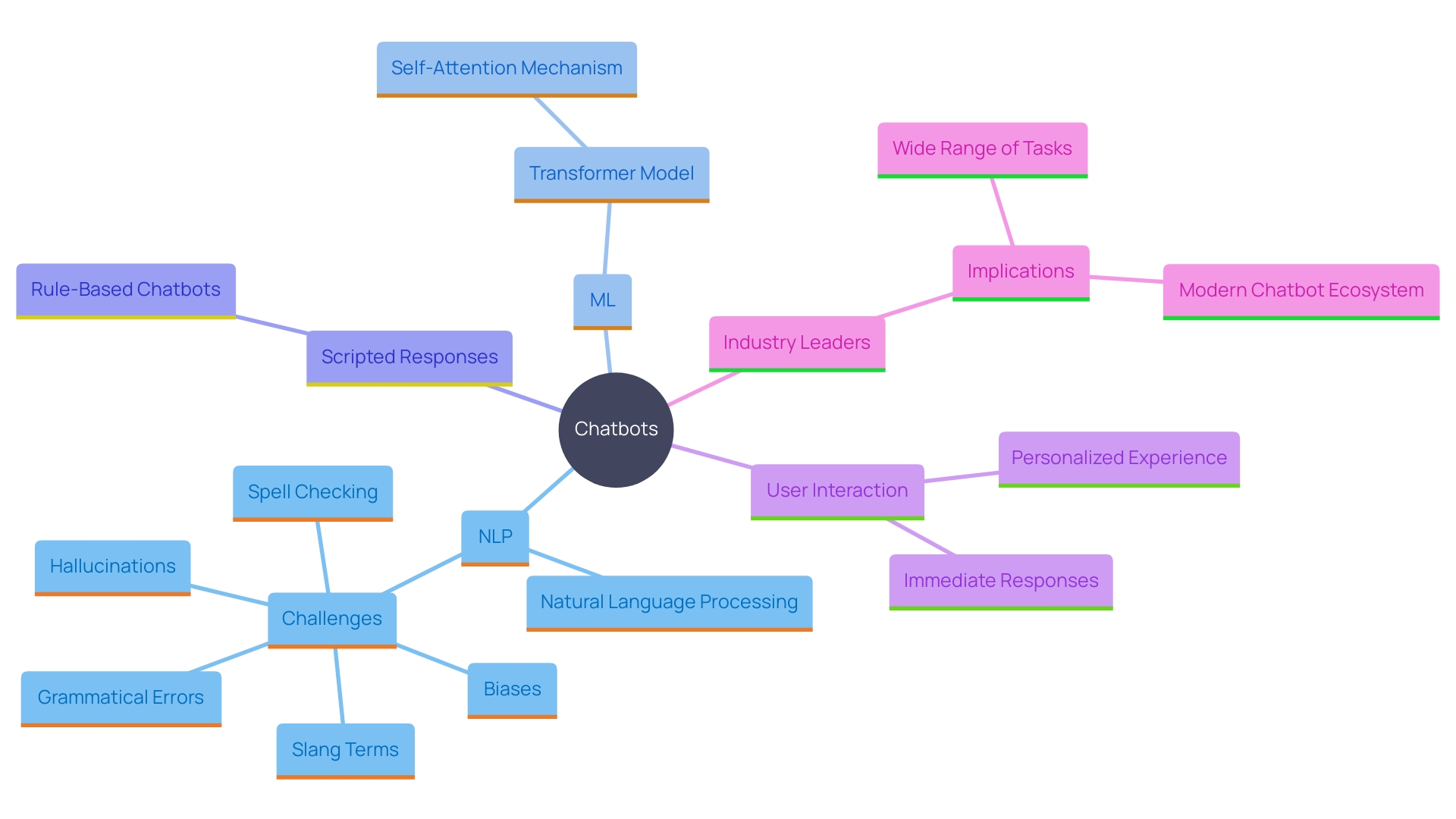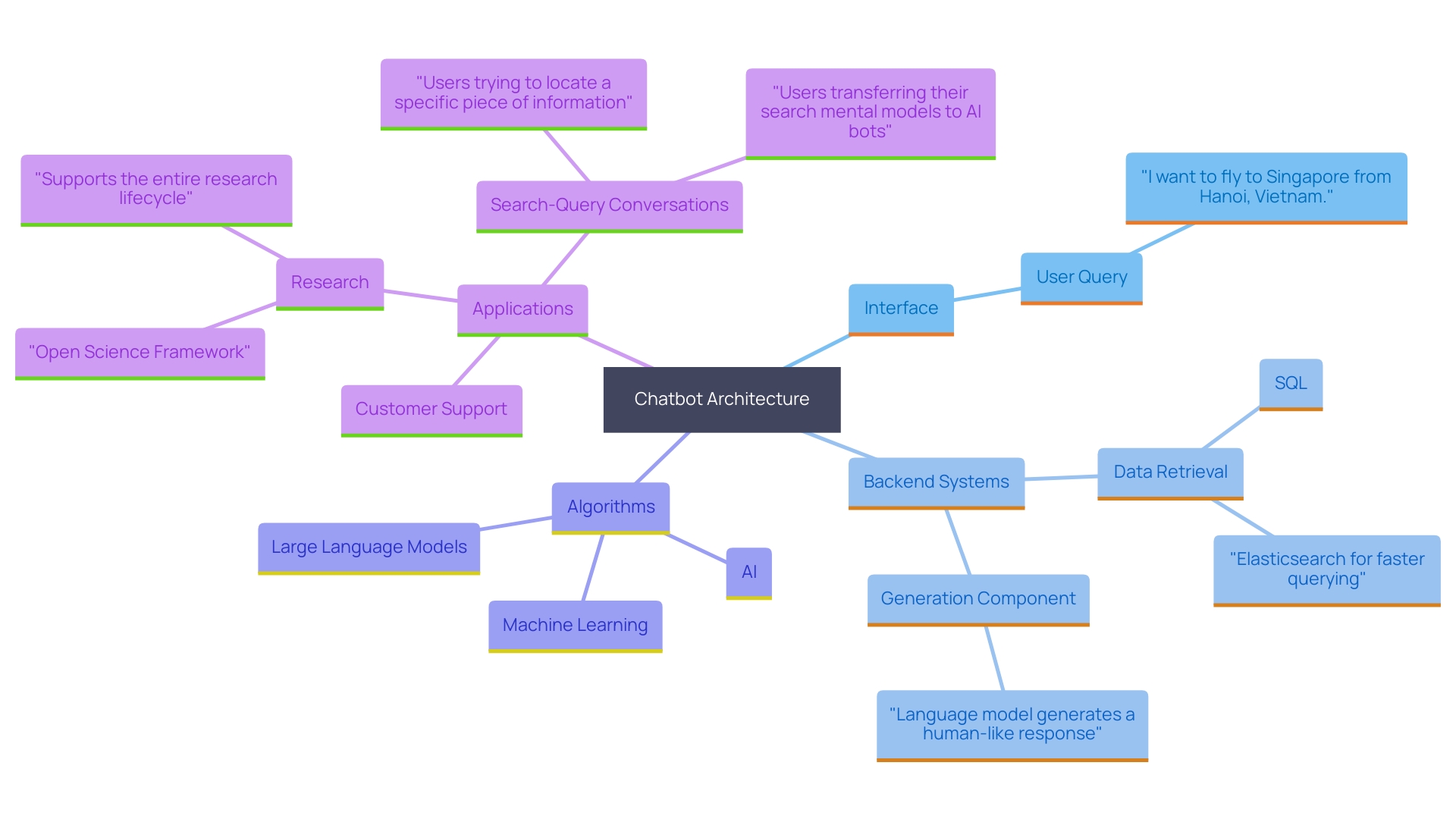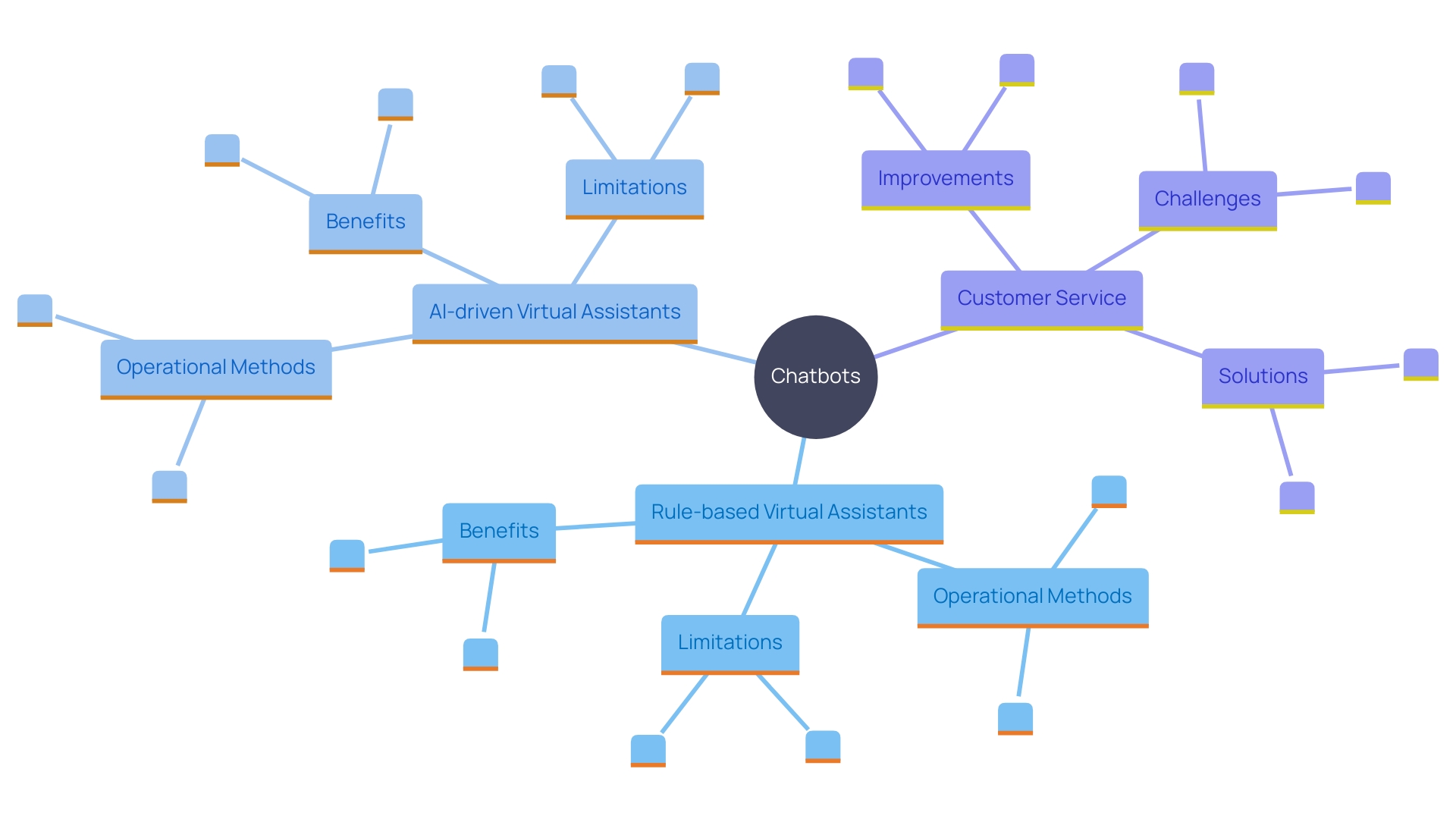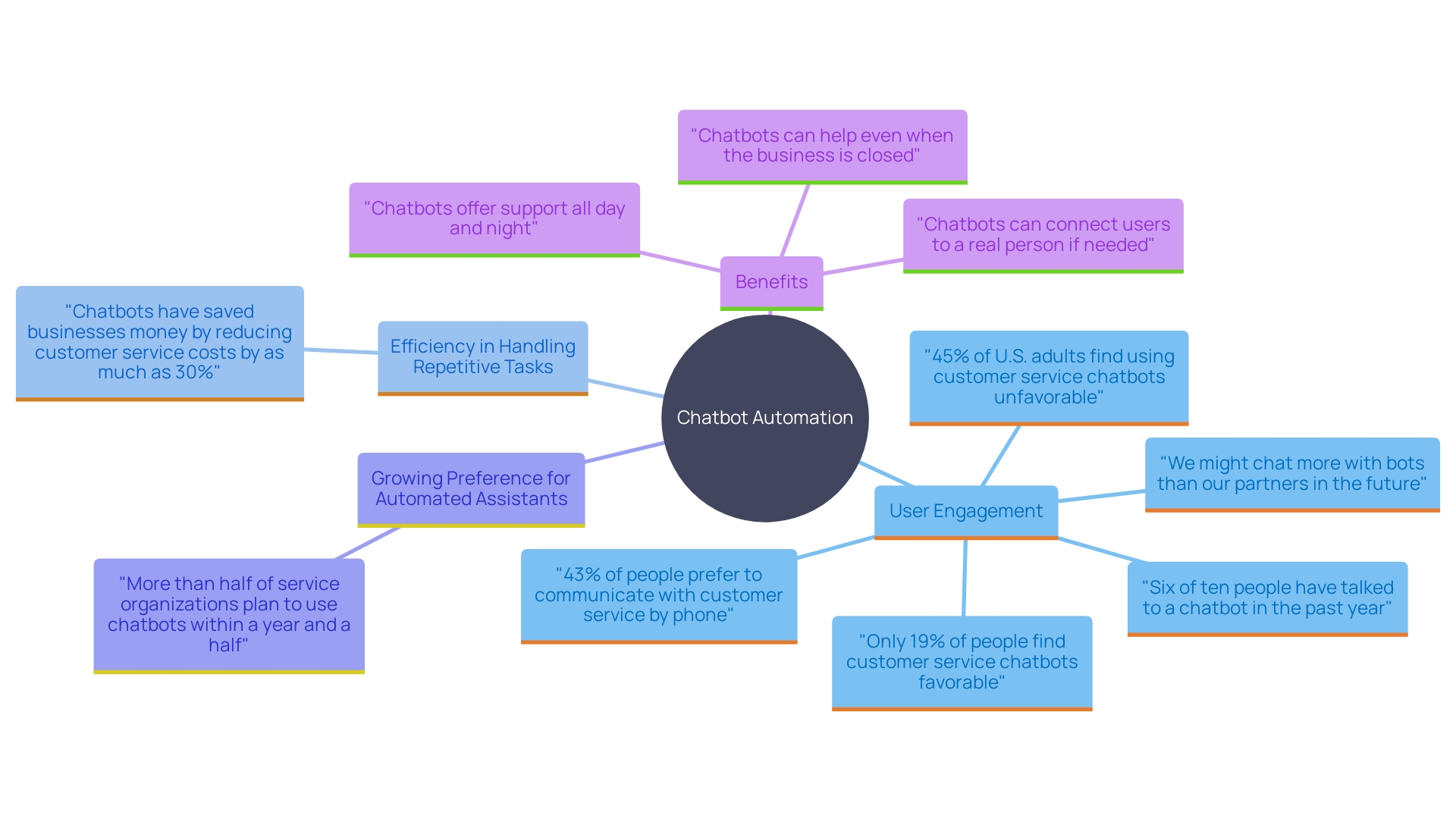Introduction
In an era where communication is paramount, chatbots have emerged as invaluable assets, revolutionizing the way organizations engage with users. These sophisticated tools, powered by natural language processing (NLP), machine learning (ML), and scripted responses, offer seamless and human-like interactions. By delving into the intricacies of chatbot architecture, the various types available, and the myriad benefits of automation, this article provides a comprehensive guide to understanding and leveraging chatbots to enhance operational efficiency and user satisfaction.
As businesses increasingly adopt this technology, the insights shared here will empower decision-makers to harness the full potential of chatbots in achieving their strategic objectives.
How Chatbots Work
Chatbots utilize a blend of natural language processing (NLP), machine learning (ML), and scripted responses to communicate effectively with individuals. By examining the individual’s input, these automated systems offer pertinent responses or actions based on predefined guidelines or data-informed trends they have acquired. This creates an interaction that closely resembles human conversation, allowing individuals to engage seamlessly with the chatbot. For instance, NLP-driven virtual assistants can adapt their responses to the user’s context and preferences, offering a more personalized experience. ‘According to Sam Altman, CEO of OpenAI, this signifies the ‘beginning of a new paradigm’ in AI, with conversational agents acting as sophisticated ‘co-pilots’ capable of handling complex tasks and delivering lightning-fast responses.’.

Key Components of Chatbot Architecture
The architecture of chatbots revolves around several core components that work cohesively to ensure seamless communication. At the forefront is the interface, which serves as the primary medium for interaction. This interface is crafted to be intuitive and responsive, enabling individuals to effortlessly navigate and interact with the chatbot.
Behind the scenes, the backend system takes the center stage. This system processes requests using a combination of algorithms and databases. These algorithms, often powered by advanced AI and machine learning models, interpret input from individuals and generate appropriate responses. The use of neural networks and probabilistic models enables the chatbot to understand and generate human-like language, enhancing the overall user experience.
Moreover, conversational agents leverage large language models (LLMs) like GPT-4 and ChatGPT, known for their exceptional performance in dialog systems. However, the training and fine-tuning of these models can be resource-intensive. Recent advancements have demonstrated how custom chatbots can be trained efficiently even on standard hardware, utilizing optimized methodologies and processors such as the 4th Generation Intel® Xeon® Scalable processors.
Chatbots are not just limited to simple interactions. They can manage a broad array of tasks, from responding to frequently asked questions to assisting individuals through processes and offering customer support. With the assistance of no-code platforms, establishing and personalizing automated conversation systems has become more accessible, allowing for tailored user experiences that align with business needs.
In real-world applications, virtual assistants have proven to be invaluable. For instance, a recent development involved optimizing a chatbot initially created by a third-party. This chatbot faced several technical challenges that needed to be addressed before it could be deployed successfully. By thoroughly analyzing and refining the chatbot, it was made ready for verification and deployment, showcasing the practical benefits of continuous optimization.
Statistics highlight the growing reliance on automated conversational agents, with approximately 1.4 billion individuals using them globally. Additionally, a substantial portion of customer support engagements are now managed by AI, highlighting the efficiency and effectiveness of automated messaging systems in contemporary communication.
As technology advances, the potential of conversational agents continues to grow, providing innovative solutions for improved user interaction and operational efficiency.

Types of Chatbots
Chatbots come in various forms, each tailored to serve distinct purposes. Rule-based virtual assistants operate on predefined scripts, managing specific inquiries through a series of if-else statements. While straightforward, they are limited in scope and flexibility. On the other hand, AI-driven virtual assistants utilize machine learning to comprehend and reply to a broader range of questions, constantly evolving to enhance precision and significance over time.
For instance, Kabannas, a collection of three hotels in the UK, implemented AI-driven virtual assistants to enhance guest interactions across their digital platforms, including webchat, WhatsApp, and email. This initiative aimed to provide 24/7 support, allowing guests to engage with the hotels at their convenience. This approach not only fostered a community feel but also significantly boosted guest satisfaction by offering immediate and relevant responses.
Statistics indicate that over fifty percent of service organizations intend to implement automated messaging systems within the upcoming eighteen months, highlighting an increasing shift towards automation in client assistance. Additionally, a study commissioned by AI voice solution Tenyx revealed that seven out of ten consumers are frustrated with current virtual agents, highlighting the need for more advanced AI conversational agents that can better understand and address user needs.
In conclusion, grasping the various kinds of conversational agents and their abilities is essential for companies aiming to improve client engagement and operational efficiency. By leveraging AI-driven chatbots, companies can provide more tailored and effective customer support, ultimately enhancing overall client experience and satisfaction.

Benefits of Chatbot Automation
Chatbot automation provides significant benefits for organizations. Not only does it enhance user engagement by offering instant responses, but it also streamlines operations by addressing repetitive tasks. This technology improves efficiency, enabling human resources to focus on more complex interactions. According to research, 67% of the worldwide population has utilized automated assistants for client assistance, emphasizing their increasing importance in today’s digital environment. Furthermore, automated assistants manage 90% of complaints instantly when queries are clearly defined, which greatly reduces response times. As customer preferences continue to shift— with 33% favoring automated assistants over phone calls for reservations— it’s evident that these tools are becoming indispensable. This shift leads to a more productive environment and greater overall satisfaction for users, a trend supported by the fact that over half of service organizations intend to implement chatbots within the next 18 months.

Conclusion
The exploration of chatbots reveals their transformative potential in enhancing communication and operational efficiency within organizations. By leveraging natural language processing and machine learning, chatbots facilitate seamless interactions that mimic human conversation. Their architecture, comprising intuitive user interfaces and sophisticated backend systems, enables them to deliver timely and relevant responses, making them invaluable tools in customer engagement.
Different types of chatbots cater to diverse needs, from simple rule-based systems to advanced AI-powered solutions. The effectiveness of AI chatbots, as demonstrated by real-world applications like those in the hospitality industry, underscores their ability to improve customer satisfaction and streamline service delivery. As businesses increasingly recognize the value of these technologies, the trend towards automation in customer service is gaining momentum.
The benefits of chatbot automation extend beyond mere convenience. By handling repetitive tasks and providing instant responses, chatbots free up valuable human resources to focus on more complex interactions. This not only enhances productivity but also aligns with shifting customer preferences, with a notable percentage favoring chatbots for their efficiency.
Embracing chatbot technology is not just a strategic move; it is essential for organizations aiming to thrive in a rapidly evolving digital landscape.

